
Zamość is a historical city in southeastern Poland. It is situated in the southern part of Lublin Voivodeship, about 90 km (56 mi) from Lublin, 247 km (153 mi) from Warsaw. In 2021, the population of Zamość was 62,021.

Cathedrals, collegiate churches, and monastic churches like those of abbeys and priories, often have certain complex structural forms that are found less often in parish churches. They also tend to display a higher level of contemporary architectural style and the work of accomplished craftsmen, and occupy a status both ecclesiastical and social that an ordinary parish church rarely has. Such churches are generally among the finest buildings locally and a source of regional pride. Many are among the world's most renowned works of architecture. These include St Peter's Basilica, Notre-Dame de Paris, Cologne Cathedral, Salisbury Cathedral, Antwerp Cathedral, Prague Cathedral, Lincoln Cathedral, the Basilica of Saint-Denis, Santa Maria Maggiore, the Basilica of San Vitale, St Mark's Basilica, Westminster Abbey, Saint Basil's Cathedral, Antoni Gaudí's incomplete Sagrada Família and the ancient cathedral of Hagia Sophia in Istanbul, now a mosque.
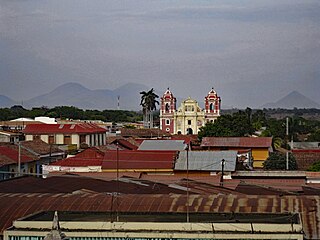
León is the second largest city in Nicaragua, after Managua. Founded by the Spanish as Santiago de los Caballeros de León, it is the capital and largest city of León Department. As of 2022, the municipality of León has an estimated population of 213,718.

Baroque architecture is a highly decorative and theatrical style which appeared in Italy in the late 16th century and gradually spread across Europe. It was originally introduced by the Catholic Church, particularly by the Jesuits, as a means to combat the Reformation and the Protestant church with a new architecture that inspired surprise and awe. It reached its peak in the High Baroque (1625–1675), when it was used in churches and palaces in Italy, Spain, Portugal, France, Bavaria and Austria. In the Late Baroque period (1675–1750), it reached as far as Russia, the Ottoman Empire and the Spanish and Portuguese colonies in Latin America. In about 1730, an even more elaborately decorative variant called Rococo appeared and flourished in Central Europe.

Ukrainian Baroque, also known as Cossack Baroque or Mazepa Baroque, is an architectural style that was widespread in Ukraine in the 17th and 18th centuries. It was the result of a combination of local architectural traditions and European Baroque.

The architecture of Russia refers to the architecture of modern Russia as well as the architecture of both the original Kievan Rus', the Russian principalities, and Imperial Russia. Due to the geographical size of modern and Imperial Russia, it typically refers to architecture built in European Russia, as well as European influenced architecture in the conquered territories of the Empire.

The Franciscan missions of the Sierra Gorda of Querétaro are five missions built in Mexico between 1750 and 1760. The foundation of the missions is attributed to Junípero Serra, who also founded the most important missions in California. They were declared a World Heritage Site by UNESCO in 2003.
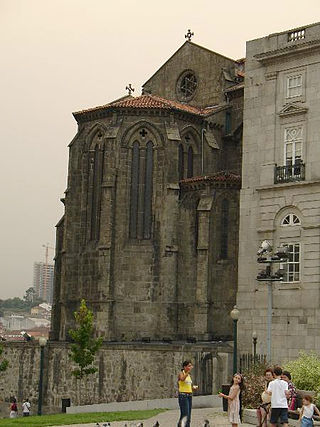
The Church of Saint Francis is the most prominent Gothic monument in Porto, Portugal, being also noted for its outstanding Baroque inner decoration. It is located in the historic centre of the city, declared World Heritage Site by UNESCO.
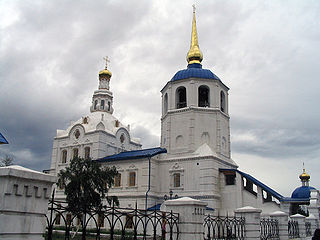
St. Odigitrievsky Cathedral is an Orthodox church, a monument of architecture of the Siberian Baroque of the middle of the 18th century in Transbaikalia. It was built in 1741–1785 in the city of Verkhneudinsk

The architecture of Hungary is understood as the architecture of the territory of Hungary, and in a wider sense the historical territory of the Kingdom of Hungary. Major European styles from Roman to Postmodern is represented, including renowned examples of Romanesque, Gothic, Renaissance, Baroque, Classical, Modern and International Style architecture.
The majority of church buildings in Brno belong to the Roman Catholic Church, others mainly to Protestant churches. In addition, there are a synagogue and a mosque. To describe the more notable ones, we can divide Brno into three areas: the city centre, the early suburbs, and former villages and large housing estates incorporated after World War I, including post-World War II developments.

The Franciscan Church of the Annunciation is a Franciscan church located on Prešeren Square in Ljubljana, the capital of Slovenia. It is the parish church of Ljubljana - Annunciation Parish. It was built on a site where two or possibly three churches stood earlier between 1646 and 1660 under the management of Francesco Olivieri and Francesco Rosina, and its exterior was redesigned in 1858 according to plans by Franz Kurz zum Thurn und Goldenstein. The frescoes in the interior were added in the mid-19th century by Matevž Langus and on the ceiling by Matej Sternen in the first half of the 20th century, whereas the main altar was mostly made by the Baroque sculptor Francesco Robba (1736). The red or pink colour of the church is symbolic of the Franciscan monastic order. Since 2008, the church has been protected as a cultural monument of national significance of Slovenia.
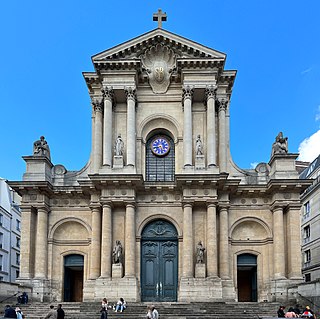
The Church of Saint-Roch is a 17th–18th-century French Baroque and classical style church in Paris, dedicated to Saint Roch. It is located at 284 rue Saint-Honoré, in the 1st arrondissement. The current church was built between 1653 and 1740.

Astrakhan Kremlin is a fortress in Astrakhan, Russia. It is located on a hill on an island in the Volga Delta, between the Volga, the Kutum, and the Tsarev.

The Church of Saint Anthony is a Catholic temple located in Patriarca Square, in the center of the Brazilian city of São Paulo. Established in 1592, the current church was completed between 1899 and 1919. It housed the Franciscan Order in the 17th century and was subordinated to the Brotherhood of Our Lady of the Rosary of White Men in the 18th century. It is a historic monument of the state and the oldest remaining church in the city.

Maltese Baroque architecture is the form of Baroque architecture that developed in Malta during the 17th and 18th centuries, when the islands were under the rule of the Order of St. John. The Baroque style was introduced in Malta in the early 17th century, possibly by the Bolognese engineer Bontadino de Bontadini during the construction of the Wignacourt Aqueduct. The style became popular in the mid to late 17th century, and it reached its peak during the 18th century, when monumental Baroque structures such as Auberge de Castille were constructed.
The architecture of Slovakia has a long, rich and diverse history. Besides Roman ruins, Slovakia hosts several Romanesque and Gothic castles and churches, most notably Spiš Castle, which were built at the time of the Kingdom of Hungary. Renaissance architecture was of particular relevance in town hall squares, such as in Bardejov and Levoča. Affluent architecture in the following centuries made use of Baroque, Rococo and historicist styles, while vernacular architecture in the countryside developed a specific style of wooden houses and wooden churches. In the 20th century, Slovakia knew Art Nouveau and modernist architecture, including socialist modernism, and finally contemporary architecture.

The Church and Convent of Saint Antony is a 17th-century Roman Catholic church located in Cairu, Bahia, Brazil. It was consecrated in 1650, but construction on the complex probably began at the beginning of the century. It is dedicated to is dedicated to Saint Anthony. The church building is noted for its elaborate façade and numerous Franciscan architectural elements. It covers 3,215 square metres (34,610 sq ft). The church was listed as a historic structure by the National Historic and Artistic Heritage Institute in 1941. The architect Mário Mendonça de Oliveira calls the convent and church "one of the most outstanding existing examples of Brazilian religious architecture and Franciscan architecture."

The Rostov Kremlin is an architectural ensemble of four complexes, built during the 16th and 17th centuries in Rostov, Yaroslavl Oblast, Russia.
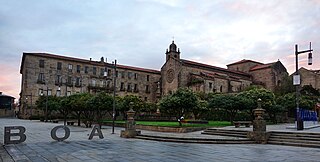
The Convent of St. Francis is a Franciscan convent located in the city centre of Pontevedra (Spain), overlooking the Plaza de la Herrería. The Gothic church of San Francis is attached to the convent on the southeast side.



















